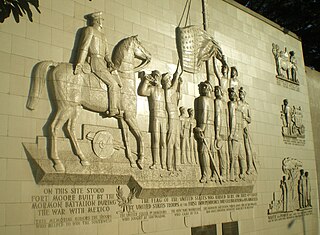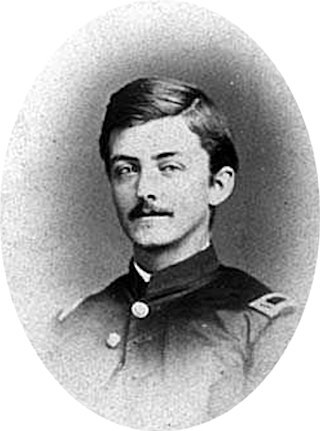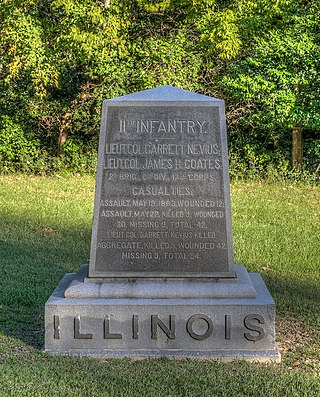
The Mormon Battalion was the only religious unit in United States military history in federal service, recruited solely from one religious body and having a religious title as the unit designation. The volunteers served from July 1846 to July 1847 during the Mexican–American War of 1846–1848. The battalion was a volunteer unit of between 534 and 559 Latter-day Saint men, led by Mormon company officers commanded by regular U.S. Army officers. During its service, the battalion made a grueling march of nearly 1,950 miles from Council Bluffs, Iowa, to San Diego, California.

Farrand Stewart Stranahan was an American Civil War veteran, a railroad executive, a banker, and a U.S. politician of the Republican Party.
The 14th Wisconsin Infantry Regiment was a volunteer infantry regiment that served in the Union Army during the American Civil War. Four of its members received the Medal of Honor for service in the Second Battle of Corinth, October 3 and 4, 1862; among them the Color-Sergeant Denis Murphy, who, though wounded 3 times, continued bearing the colors throughout the battle.
The 24th Wisconsin Infantry Regiment was a volunteer infantry regiment that served in the Union Army during the American Civil War.
The 2nd Wisconsin Cavalry Regiment was a volunteer cavalry regiment that served in the Union Army in the western theater of the American Civil War.
The 96th Regiment Illinois Volunteer Infantry was an infantry regiment that served in the Union Army during the American Civil War.

Samuel M. Whitside was a United States Cavalry officer who served from 1858 to 1902. He commanded at every level from company to department for 32 of his 43 years in service, including Army posts such a Camp Huachuca, Jefferson Barracks, and Fort Sam Houston, the Departments of Eastern Cuba and Santiago and Puerto Principe, Cuba, commanded a provisional cavalry brigade, a squadron in the 7th Cavalry Regiment, and a troop and platoon in the 6th Cavalry Regiment. The pinnacle of his career was serving as the commanding general of the Department of Eastern Cuba before retiring in June 1902 as a brigadier general in the U.S. Army.
The Missouri State Militia was a federally funded state militia organization of Missouri conceived in 1861 and beginning service in 1862 during the American Civil War. It was a full-time force whose primary purpose was to conduct offensive operations against Confederate guerrillas and recruiters as well as oppose raids by regular Confederate forces. The militia at one time numbered more than 13,000 soldiers, but this force was reduced to 10,000 soldiers, by the United States government.

The Utah Territory during the American Civil War was far from the main operational theaters of war, but still played a role in the disposition of the United States Army, drawing manpower away from the volunteer forces and providing its share of administrative headaches for the Lincoln Administration. Although no battles were fought in the territory, the withdrawal of Union forces at the beginning of the war allowed the Native American tribes to start raiding the trails passing through Utah. As a result, units from California and Utah were assigned to protect against these raids. Mineral deposits found in Utah by California soldiers encouraged the immigration of non-Mormon settlers into Utah.

The 2nd Regiment California Volunteer Cavalry was a cavalry regiment in the Union Army during the American Civil War. It spent its entire term of service in the western United States, with most of its companies dispersed to various posts.

Henry M. Fox was a Union soldier during the American Civil War, and a Medal of Honor recipient.

1st Battalion California Volunteer Mountaineers was an infantry battalion in the Union Army during the American Civil War. It spent its entire term of service in the western United States, attached to the Department of the Pacific. It was organized from men from the counties of Humboldt, Mendocino, Trinity, Klamath, Siskiyou, and Del Norte, and other parts of California, between May 30, 1863, and March 16, 1864, for special service in the redwood forests and mountains that was being fought over in the Bald Hills War in Humboldt County within the Humboldt Military District. The Battalion mustered out June 14, 1865.
United States Volunteers also known as U.S. Volunteers, U.S. Volunteer Army, or other variations of these, were military volunteers called upon during wartime to assist the United States Army but who were separate from both the Regular Army and the militia.

Thomas Parke Gere was a Union Army officer who received the Medal of Honor for his actions during the Battle of Nashville in the American Civil War.

John Wainwright was a United States military officer during the American Civil War. A native of Syracuse, New York, he was awarded his nation's highest award for valor, the Medal of Honor, for his "gallant and meritorious conduct" while serving in the Union Army as a first lieutenant with the 97th Pennsylvania Infantry during the Second Battle of Fort Fisher, North Carolina on January 15, 1865.

The 6th Maine Infantry Regiment was an infantry regiment that served in the Union Army during the American Civil War.

The 11th Regiment Illinois Volunteer Infantry was an infantry regiment from Illinois that served in the Union Army during the American Civil War. In April 1861, it was formed as a three-month volunteer unit, and in July 1861 it was reorganized as a three-year unit, in which role it served until the end of the war. Two of its commanding officers were promoted to brigadier general and led major units during the war. In its first major action at Fort Donelson the regiment suffered terrible losses. The 11th Illinois also fought at Shiloh, Riggins Hill, Vicksburg, First Yazoo City, Second Yazoo City, and Fort Blakely. In April 1863, the 109th Illinois Infantry Regiment was disbanded and its enlisted men transferred into the 11th Illinois. The regiment was mustered out of service in July 1865.
Company "A", Pennsylvania (Colored) Infantry was a United States Colored Troops unit briefly formed during the Civil War in the Union Army. The unit was organized at Camp William Penn, Pennsylvania on July 28, 1864 It was named for its commander, Captain Converse Southard. The unit was disbanded November 14, 1864 at Philadelphia, Pennsylvania and its remaining members sent to reinforce existing U.S.C.T. regiments.
Camp Babbitt was an American Civil War Union Army camp located in two sites in the vicinity of Visalia, California.
A regiment is a military unit that has been in use by the United States Army since its inception. Derived from the concept originating in European armies, a regiment was historically commanded by a colonel, and consisted of ten companies, for a total of approximately 1,000 soldiers. Confusingly, the terms "regiment" and "battalion" were used interchangeably at this time; it was not until later that a battalion was defined as a sub-unit of a regiment. The regiment fulfilled both administrative and tactical functions and was the principal maneuver unit of the US Army until being superseded in the 20th century by the division.












